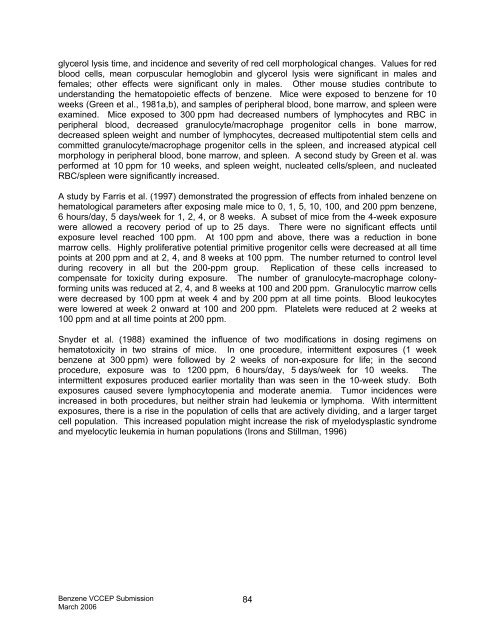(VCCEP) Tier 1 Pilot Submission for BENZENE - Tera
(VCCEP) Tier 1 Pilot Submission for BENZENE - Tera
(VCCEP) Tier 1 Pilot Submission for BENZENE - Tera
You also want an ePaper? Increase the reach of your titles
YUMPU automatically turns print PDFs into web optimized ePapers that Google loves.
glycerol lysis time, and incidence and severity of red cell morphological changes. Values <strong>for</strong> red<br />
blood cells, mean corpuscular hemoglobin and glycerol lysis were significant in males and<br />
females; other effects were significant only in males. Other mouse studies contribute to<br />
understanding the hematopoietic effects of benzene. Mice were exposed to benzene <strong>for</strong> 10<br />
weeks (Green et al., 1981a,b), and samples of peripheral blood, bone marrow, and spleen were<br />
examined. Mice exposed to 300 ppm had decreased numbers of lymphocytes and RBC in<br />
peripheral blood, decreased granulocyte/macrophage progenitor cells in bone marrow,<br />
decreased spleen weight and number of lymphocytes, decreased multipotential stem cells and<br />
committed granulocyte/macrophage progenitor cells in the spleen, and increased atypical cell<br />
morphology in peripheral blood, bone marrow, and spleen. A second study by Green et al. was<br />
per<strong>for</strong>med at 10 ppm <strong>for</strong> 10 weeks, and spleen weight, nucleated cells/spleen, and nucleated<br />
RBC/spleen were significantly increased.<br />
A study by Farris et al. (1997) demonstrated the progression of effects from inhaled benzene on<br />
hematological parameters after exposing male mice to 0, 1, 5, 10, 100, and 200 ppm benzene,<br />
6 hours/day, 5 days/week <strong>for</strong> 1, 2, 4, or 8 weeks. A subset of mice from the 4-week exposure<br />
were allowed a recovery period of up to 25 days. There were no significant effects until<br />
exposure level reached 100 ppm. At 100 ppm and above, there was a reduction in bone<br />
marrow cells. Highly proliferative potential primitive progenitor cells were decreased at all time<br />
points at 200 ppm and at 2, 4, and 8 weeks at 100 ppm. The number returned to control level<br />
during recovery in all but the 200-ppm group. Replication of these cells increased to<br />
compensate <strong>for</strong> toxicity during exposure. The number of granulocyte-macrophage colony<strong>for</strong>ming<br />
units was reduced at 2, 4, and 8 weeks at 100 and 200 ppm. Granulocytic marrow cells<br />
were decreased by 100 ppm at week 4 and by 200 ppm at all time points. Blood leukocytes<br />
were lowered at week 2 onward at 100 and 200 ppm. Platelets were reduced at 2 weeks at<br />
100 ppm and at all time points at 200 ppm.<br />
Snyder et al. (1988) examined the influence of two modifications in dosing regimens on<br />
hematotoxicity in two strains of mice. In one procedure, intermittent exposures (1 week<br />
benzene at 300 ppm) were followed by 2 weeks of non-exposure <strong>for</strong> life; in the second<br />
procedure, exposure was to 1200 ppm, 6 hours/day, 5 days/week <strong>for</strong> 10 weeks. The<br />
intermittent exposures produced earlier mortality than was seen in the 10-week study. Both<br />
exposures caused severe lymphocytopenia and moderate anemia. Tumor incidences were<br />
increased in both procedures, but neither strain had leukemia or lymphoma. With intermittent<br />
exposures, there is a rise in the population of cells that are actively dividing, and a larger target<br />
cell population. This increased population might increase the risk of myelodysplastic syndrome<br />
and myelocytic leukemia in human populations (Irons and Stillman, 1996)<br />
Benzene <strong>VCCEP</strong> <strong>Submission</strong><br />
March 2006<br />
84





